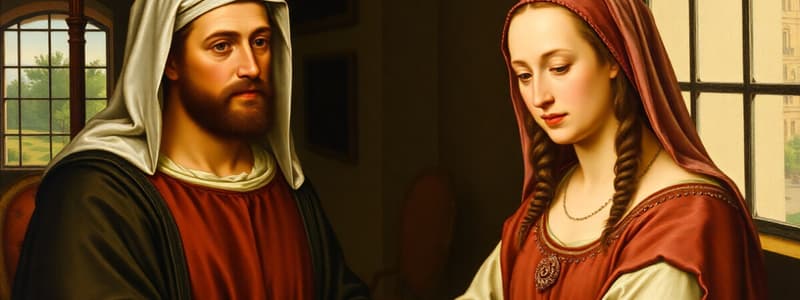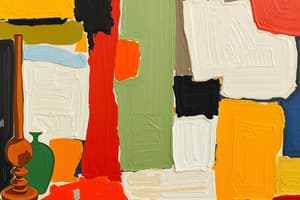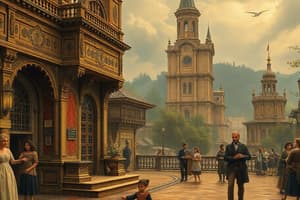Podcast
Questions and Answers
What was the primary factor that led wealthy families, guilds, and religious confraternities to become patrons of the arts during the Renaissance?
What was the primary factor that led wealthy families, guilds, and religious confraternities to become patrons of the arts during the Renaissance?
- The need to display wealth and status explicitly.
- The belief in their moral responsibility to lead the community. (correct)
- To compete with other cities in artistic achievements.
- A desire to collect art for personal enjoyment.
Which architectural style did Filippo Brunelleschi reject in favor of Roman-inspired designs?
Which architectural style did Filippo Brunelleschi reject in favor of Roman-inspired designs?
- Gothic (correct)
- Rococo
- Baroque
- Neoclassical
What characterized Renaissance architecture in Florence during the 15th century?
What characterized Renaissance architecture in Florence during the 15th century?
- Use of pointed arches and flying buttresses.
- Large, ornate structures with intricate details.
- Elegant simplicity with plain walls and colored frames. (correct)
- Focus on massive stone buildings and fortifications.
What was a notable influence on painting and sculpture during the Renaissance?
What was a notable influence on painting and sculpture during the Renaissance?
What role did the Medici family play in the Renaissance art scene?
What role did the Medici family play in the Renaissance art scene?
What was the societal status of artists during the Renaissance compared to the Middle Ages?
What was the societal status of artists during the Renaissance compared to the Middle Ages?
In what way did patrons influence the creation of art during the Renaissance?
In what way did patrons influence the creation of art during the Renaissance?
What was the main theme for Renaissance artists in their quest for artistic representation?
What was the main theme for Renaissance artists in their quest for artistic representation?
Flashcards
Renaissance Patrons
Renaissance Patrons
Rich individuals and organizations, such as wealthy families, guilds, and religious groups, who supported artists and artistic creations during the Renaissance.
Classical Revival in Renaissance Architecture
Classical Revival in Renaissance Architecture
The revival of classical styles, particularly Roman architecture, during the Renaissance, characterized by the use of columns, arches, and other architectural elements.
Filippo Brunelleschi
Filippo Brunelleschi
An influential architect of the Renaissance, best known for designing the dome of Florence Cathedral and other prominent buildings, who rejected the Gothic style in favor of classical Roman architecture.
Medieval Painting
Medieval Painting
Signup and view all the flashcards
Renaissance Artists and the Beauty of the Soul
Renaissance Artists and the Beauty of the Soul
Signup and view all the flashcards
The Medici Family
The Medici Family
Signup and view all the flashcards
Moral Leadership in the Renaissance
Moral Leadership in the Renaissance
Signup and view all the flashcards
“Gud” (High Art)
“Gud” (High Art)
Signup and view all the flashcards
Study Notes
Renaissance Art
- Renaissance artists emphasized elegant simplicity, combining plain arches, doors, windows, and white walls with color accents.
- Filippo Brunelleschi applied classical architectural theories to the Foundling Hospital and Florence Cathedral (Duomo).
- Artists rejected the northern Gothic style, opting for vaulted ceilings and pointed arches.
- Wealthy families, guilds, and religious groups were major art patrons.
Patronage and the Arts
- Wealthy patrons specified subject matter, details, and even the size and price of commissioned works.
- Patronage included saints, family members, and other figures featured in the artwork.
- Costs of materials and artist's time were important considerations.
- Commissions involved specific details, subject matter, and desired size/price.
Renaissance Artists
- Artists sought to represent beauty and eternal ideas, often surpassing human nature.
- They aimed to capture the essence of the soul through their art.
- The use of perspective and the representation of nature, objects, and human emotions were hallmarks of Renaissance art.
- Renaissance art reflected the humanist ideal of beauty.
- Artists like Leonardo da Vinci explored complex emotions in their subjects.
Painting and Sculpture
- Renaissance art reflected the influence of Neoplatonic ideas that emphasized eternal ideals of beauty, truth, and goodness.
- Patronage and commissions played a significant role in art at the time that determined the artist's work.
- Patron-artist relationships were critical to shaping art-making practices.
- Artists often sought to convey emotions and passions through their work.
Studying That Suits You
Use AI to generate personalized quizzes and flashcards to suit your learning preferences.




